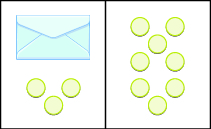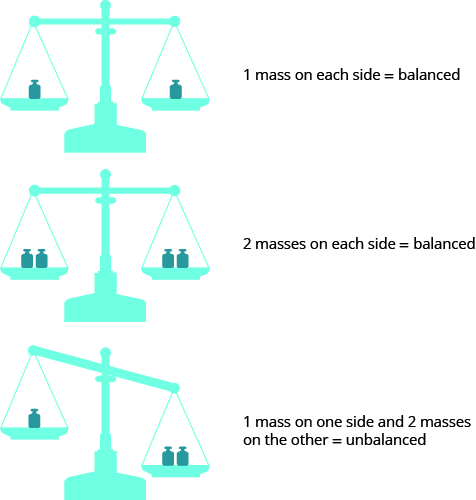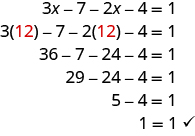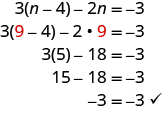| << Chapter < Page | Chapter >> Page > |
When you add or subtract the same quantity from both sides of an equation, you still have equality.
We introduced the Subtraction Property of Equality earlier by modeling equations with envelopes and counters. [link] models the equation

The goal is to isolate the variable on one side of the equation. So we ‘took away’ from both sides of the equation and found the solution
Some people picture a balance scale, as in [link] , when they solve equations.

The quantities on both sides of the equal sign in an equation are equal, or balanced. Just as with the balance scale, whatever you do to one side of the equation you must also do to the other to keep it balanced.
Let’s review how to use Subtraction and Addition Properties of Equality to solve equations. We need to isolate the variable on one side of the equation. And we check our solutions by substituting the value into the equation to make sure we have a true statement.
Solve:
To isolate we undo the addition of by using the Subtraction Property of Equality.
|
| ||
| Subtract 11 from each side to "undo" the addition. |
| |
| Simplify. |
| |
| Check: |
|
|
| Substitute . |
|
|
|
|
Since makes a true statement, we know that it is a solution to the equation.
In the original equation in the previous example, was added to the , so we subtracted to ‘undo’ the addition. In the next example, we will need to ‘undo’ subtraction by using the Addition Property of Equality .
Solve:
|
| ||
| Add 4 to each side to "undo" the subtraction. |
| |
| Simplify. |
| |
| Check: |
|
|
| Substitute . |
|
|
|
|
||
| The solution to is . |
Now let’s review solving equations with fractions.
Solve:
|
| ||
| Use the Addition Property of Equality. |
| |
| Find the LCD to add the fractions on the right. |
| |
| Simplify |
| |
| Check: |
|
|
|
|
|
|
| Subtract. |
|
|
| Simplify. |
|
|
| The solution checks. |
In Solve Equations with Decimals , we solved equations that contained decimals. We’ll review this next.
Solve
|
| ||
| Use the Addition Property of Equality. |
| |
| Add. |
| |
| Check: |
|
|
| Substitute . |
|
|
| Simplify. |
|
|
| The solution checks. |
In the examples up to this point, we have been able to isolate the variable with just one operation. Many of the equations we encounter in algebra will take more steps to solve. Usually, we will need to simplify one or both sides of an equation before using the Subtraction or Addition Properties of Equality. You should always simplify as much as possible before trying to isolate the variable.
Solve:
The left side of the equation has an expression that we should simplify before trying to isolate the variable.
|
| |
| Rearrange the terms, using the Commutative Property of Addition. |
|
| Combine like terms. |
|
| Add 11 to both sides to isolate . |
|
| Simplify. |
|
| Check.
Substitute into the original equation.  |
The solution checks.
Solve:
The left side of the equation has an expression that we should simplify.
|
| |
| Distribute on the left. |
|
| Use the Commutative Property to rearrange terms. |
|
| Combine like terms. |
|
| Isolate n using the Addition Property of Equality. |
|
| Simplify. |
|
| Check.
Substitute into the original equation. 
The solution checks. |

Notification Switch
Would you like to follow the 'Prealgebra' conversation and receive update notifications?